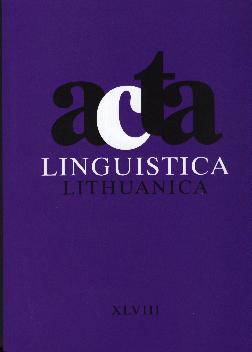Linksnių atrakcija lyginamosiose konstrukcijose
Case attraction in comparative constructions
Author(s): Veslava Čižik-ProkaševaSubject(s): Language and Literature Studies
Published by: Lietuvių Kalbos Institutas
Keywords: Lithuanian; comparative constructions; case attraction; case hierarchy
Summary/Abstract: The paper deals with the case marking of nouns in reduced comparative clauses in Lithuanian. A nominative, expected in a reduced comparative clause on the grounds of its performing the syntactic function of subject in the corresponding full comparative clause (as in Reikai gyventi kaip drugelis ‘One should live as a butterfly’ instead of Reikia gyventi (taip), kaip gyvena drugelis ‘One should live as a butterfly lives’) is often optionally replaced with an oblique case, as the noun copies the case marking of the matrix clause noun for which it acts as a standard of comparison. This occurs (i) in adverbial comparative clauses introduced by (taip), kaip ‘so .. as’, e.g., Reikia gyventi kaip drugeliuiDAT instead of Reikia gyventi kaip drugelisNOM, and (ii) in adjectival comparative clauses of the type (toks), kaip ‘such ...as’, e.g., Malonu gauti tokias dovanas kaip ˛aislusACC instead of Malonu gauti tokias dovanas kaip ˛aislaiNOM ‘It’s nice to get such gifts as toys’. This case attraction appears to be restrained by two factors: (i) an animacy hierarchy (proper names never undergo attraction, pronouns rarely do), and (ii) a case hierarchy (the nominative is often replaced with an accusative, less frequently with a genitive or dative, and virtually never with an instrumental).
Journal: Acta Linguistica Lithuanica
- Issue Year: 2003
- Issue No: 48
- Page Range: 1-17
- Page Count: 17
- Language: Lithuanian

